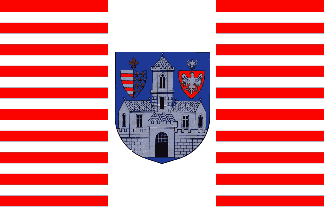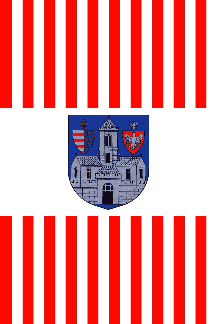
image by István Molnár, 3 March 2001

Last modified: 2014-04-18 by zoltán horváth
Keywords: hungary | budapest | obuda | bekasmegyar | eagle |
Links: FOTW homepage |
search |
disclaimer and copyright |
write us |
mirrors

image by István Molnár, 3 March 2001
See also:
I have seen these flags in October in Budapest and took some
photos.
István Molnár, 3 March 2001
Concerning Ralf
Hartemink site - The correct name is Budapest III.
Óbuda-Békásmegyer. The district is the union of the formerly
Óbuda town (in 1873 united with Buda and Pest cities to
Budapest) and the German inhabited Békásmegyer (Krottendorf)
village (united in 1950). The original blue is darker.
Istvan Molnar, 9 June 2001

image by István Molnár, 3 March 2001
bp-3.jpg)
image
from <www.obuda.hu>,
located by István Molnár
Description from <www.obuda.hu>:
"Óbuda's crest - The first seal, known by us was used
between 1370-1380, under the ruling of King Louis The Great. It
had been readapted several times until the Turkish occupation,
but that design was forgotten later. At the beginning of the new
age the figure of the natural lily, later the tulip was applied
on the official seal as a symbol for agriculture. In 1991 the
district coloured and inserted the seal-figure from the age of
Anjou in its newly created crest. On the escutcheon, shaped of a
triangle, in the blue field, the castle of Queen Elisabeth- the
mother of King Louis the Great- can be seen, being an accurate
copy of the original one. The archaeological excavations have
brought the foundation onto the surface in Kálvin lane during
our century. In the picture of the crest, behind the castle's
silver wall there is a tower rising in the middle and on its
right and left side there is a tile-roofed building with 2
windows leaning on it as a reflection. Their glaze is also
silver. Above, on the one side of the tower the Anjou crest can
be seen. An escutcheon divided by a triangle-shaped slash, with a
field cut into 7 parts. The red and silver coloured motif in
other words the Árpád stripes, referring to the relationship
between the Anjou and Árpád dynasties. Opposite side Anjou
lilies are filling out the space in the blue field. Above there
is a golden Anjou lily floating. On the other side of the tower,
also an escutcheon; in a red field, silver Piast-eagle can be
seen referring to the fact, that Queen Elisabeth descended from
the Polish reigning dynasty. Above the escutcheon there is a
smaller version of the silver eagle"
István Molnár, 15 February 2001